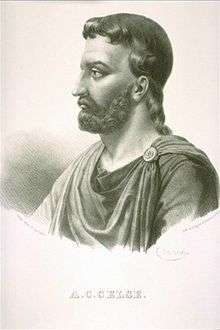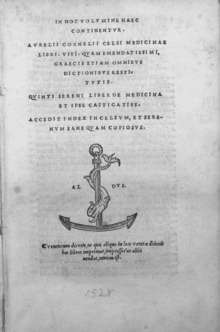Aulus Cornelius Celsus
| Aulus Cornelius Celsus | |
|---|---|
 | |
| Born | c. 25 BC |
| Died | c. 50 AD |
| Occupation | Encyclopaedist |
Aulus Cornelius Celsus (c. 25 BC – c. 50 AD) was a Roman encyclopaedist, known for his extant medical work, De Medicina, which is believed to be the only surviving section of a much larger encyclopedia. The De Medicina is a primary source on diet, pharmacy, surgery and related fields, and it is one of the best sources concerning medical knowledge in the Roman world. The lost portions of his encyclopedia likely included volumes on agriculture, law, rhetoric, and military arts. He made contributions to the classification of human skin disorders in dermatology, such as Myrmecia, and his name is often occurring in medical terms about the skin, e.g., kerion celsi and area celsi.[1]
Life
Nothing is known about the life of Celsus. Even his praenomen is uncertain; he has been called both Aurelius and Aulus, with the latter being more plausible.[2] Some incidental expressions in his De Medicina suggest that he lived under the reigns of Augustus and Tiberius; which is confirmed by his reference to Themison as being recently in his old age.[3] It is not known with any certainty where he lived. He has been identified as the possible dedicator of a gravestone in Rome, but it has also been supposed that he lived in Narbonese Gaul, because he refers to a species of vine (marcum) which, according to Pliny,[4] was native to that region.[5] It is doubtful whether he practised medicine himself, and although Celsus seems to describe and recommend his own medical observations sanctioned by experience, Quintilian says that his volumes included all sorts of literary matters, and even agriculture and military tactics.[6]
Works

Of the numerous volumes of his encyclopedia, only one remains intact, his celebrated treatise On Medicine (De Medicina). "The work’s encyclopedic arrangement follows the tripartite division of medicine at the time as established by Hippocrates and Asclepiades — diet, pharmacology, and surgery."[7] It is divided into eight books.
- Book 1 – The History of Medicine (includes references to eighty medical authors, some of whom are known only through this book[8])
- Book 2 – General Pathology
- Book 3 – Specific Diseases
- Book 4 – Parts of the Body
- Book 5 and 6 – Pharmacology
- Book 7 – Surgery
- Book 8 – Orthopedics
In the "Prooemium" or introduction to De Medicina there is an early discussion of the relevance of theory to medical practice and the pros and cons of both animal experimentation and human experimentation.
In the treatment of disease, Celsus' principal method was to observe and watch over the operations of Nature, and to regulate rather than oppose them, conceiving that fever consisted essentially in an effort of the body to throw off some morbid cause, and that, if not unduly interfered with, the process would terminate in a state of health. On occasions, however, he boldly recommends the use of the scalpel; his rules for blood letting and purgatives are laid down with detail and precision;[9] and many of the rules he prescribes were not very different from those still in use at the beginning of the 19th century. His work contains detailed descriptions of the symptoms and different varieties of fever,[10] and he is credited with recording the cardinal signs of inflammation known as "Celsus tetrad": calor (warmth), dolor (pain), tumor (swelling) and rubor (redness and hyperaemia). He goes into great detail regarding the preparation of numerous ancient medicinal remedies including the preparation of opioids. In addition, he describes many 1st century Roman surgical procedures which included removal of a cataract, treatment for bladder stones, and the setting of fractures.
During the twentieth century, many historians claimed that Celsus believed that the crystalline lens is in the exact center of the eye. In fact, Celsus made no specific statement about the position of the crystalline lens, and his Graeco-Roman contemporaries did understand that the lens is located to the front.[11]
Hippocrates used the Greek word carcinos, meaning crab or crayfish, to refer to malignant tumors. It was Celsus who translated the Greek term into the Latin cancer, also meaning crab.
The first printed edition of Celsus' work was published in 1478. His style has been much admired as being equal in purity and elegance to that of the best writers of the Augustan age.
Also, Celsus wrote a technical work on agriculture, on which Columella partly based his De Re Rustica.
- In hoc volvmine haec continentvr Avrelii Cornelii Celsi medicinae libri VIII : qvam emendatissimi, Graecis etiam omnibvs dictionibvs restitvtis. Beigefügte Werke: Qvinti Sereni Liber de medicina et ipse castigatiss. Accedit index in Celsvm et Serenvm sane qvam copiosvs ... [Hrsg.: Ioannes Baptista Egnatius]. Venetiis : in aedibvs Aldi et Andreae Asvlani soceri, 1528. Digital edition of the University and State Library Düsseldorf.
- Aurelii Cornelij Celsi de arte Medica libri octo : multis in Locis iam emendatiores longè, quàm unquam antea, editi . Beigefügte Werke: Accessit quoque Rerum & Verborum in hisce omnibus memorabilium locupletissimus Index . Basileae : Oporinus, 1552 Digital edition of the University and State Library Düsseldorf.
- Aur. Corn. Celsi De medicina : libri octo ; cum notis integris Joannis Caesarii, Roberti Constantini, Josehi Scaligeri, Isaaci Casauboni, Joannis Baptistae Morgagni, Ac locis parallelis. Lugduni Batavorum : Joh. Arn. Langerak, 1746. Digital edition of the University and State Library Düsseldorf.
References
- ↑ Rosenthal T (1961). "Aulus Cornelius Celsus - his contributions to Dermatology". Arch Dermatol. 84 (4): 613–618. doi:10.1001/archderm.1961.01580160077013.
- ↑ "Traditionally he is called Aurelius, but Aurelius is a clan name, not a praenomen; hence Aulus, a common first name among the Cornelii, has been suggested and has manuscript support." - The McGraw-Hill encyclopedia of world biography, (1973), page 448.
- ↑ Celsus, De Medicina, praef.; iii. 4
- ↑ Pliny, Hist. Nat. xiv. 32
- ↑ "He has been identified with the dedicator of a gravestone from Rome. On the other hand, the rare name Cornelius Celsus occurs on a few inscriptions from Tarraco and Narbo. ... In the part of his work on agriculture, Celsus mentioned (Col. 3. 2. 25) a species of vine (marcum) which, according to Pliny (Nat. 14. 32), is native to Narbonese Gaul." - D. R. Langslow, (2000), Medical Latin in the Roman Empire, page 43. Oxford University Press
- ↑ Quintilian, xii. 11
- ↑ "On Medicine - De medicina". World Digital Library. Retrieved 2014-03-01.
- ↑ Magill, Frank Northen; Aves, Alison (1998). Dictionary of World Biography. Taylor & Francis. ISBN 9781579580407. Retrieved 25 August 2013.
- ↑ Celsus, De Medicina, ii. 10, etc.
- ↑ Celsus, De Medicina, iii. 3, etc.
- ↑ Leffler CT, Hadi TM, Udupa A, Schwartz SG, Schwartz D (2016). "A medieval fallacy: the crystalline lens in the center of the eye". Clinical Ophthalmology. 2016 (10): 649–662.
External links
| Wikimedia Commons has media related to Aulus Cornelius Celsus. |
- De Medicina at LacusCurtius (Latin original and English translation)